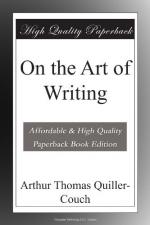Or take Shakespeare. I wager you that no writer of English so constantly chooses the concrete word, in phrase after phrase forcing you to touch and see. No writer so insistently teaches the general through the particular. He does it even in “Venus and Adonis” (as Professor Wendell, of Harvard, pointed out in a brilliant little monograph on Shakespeare, published some ten years ago). Read any page of “Venus and Adonis” side by side with any page of Marlowe’s “Hero and Leander” and you cannot but mark the contrast: in Shakespeare the definite, particular, visualised image, in Marlowe the beautiful generalisation, the abstract term, the thing seen at a literary remove. Take the two openings, both of which start out with the sunrise. Marlowe begins:—
Now had the Morn espied her lover’s
steeds:
Whereat she starts, puts on her purple
weeds,
And, red for anger that he stay’d
so long,
All headlong throws herself the clouds
among.
Shakespeare wastes no words on Aurora and her feelings, but gets to his hero and to business without ado:—
Even as the sun with purple-colour’d
face—
(You have the sun visualised at once),
Even as the sun with purple-colour’d
face
Had ta’en his last leave of the
weeping morn,
Rose-cheek’d Adonis hied him to
the chase;
Hunting he loved, but love he laugh’d
to scorn.
When Shakespeare has to describe a horse, mark how definite he is:—
Round-hoof’d, short-jointed, fetlocks
shag and long,
Broad breast, full eye, small head and
nostril wide,
High crest, short ears, straight legs
and passing strong;
Thin mane, thick tail, broad buttock,
tender hide.
Or again, in a casual simile, how definite:—
Upon this promise did
he raise his chin,
Like a dive-dipper peering
through a wave,
Which, being look’d
on, ducks as quickly in.
Or take, if you will, Marlowe’s description of Hero’s first meeting Leander:—
It lies not in our power
to love or hate,
For will in us is over-ruled
by fate...,
and set against it Shakespeare’s description of Venus’ last meeting with Adonis, as she came on him lying in his blood:—
Or as a snail whose
tender horns being hit
Shrinks backward in
his shelly cave with pain,
And there, all smother’d
up, in shade doth sit,
Long after fearing to
creep forth again;
So, at his
bloody view—
I do not deny Marlowe’s lines (if you will study the whole passage) to be lovely. You may even judge Shakespeare’s to be crude by comparison. But you cannot help noting that whereas Marlowe steadily deals in abstract, nebulous terms, Shakespeare constantly uses concrete ones, which later on he learned to pack into verse, such as:—
Sleep that knits up the ravell’d sleeve of care.
Is it unfair to instance Marlowe, who died young? Then let us take Webster for the comparison; Webster, a man of genius or of something very like it, and commonly praised by the critics for his mastery over definite, detailed, and what I may call solidified sensation. Let us take this admired passage from his “Duchess of Malfy":—




